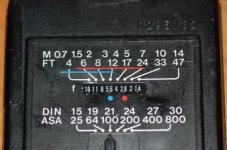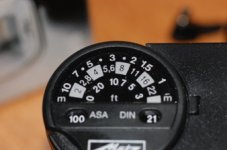Robland
Member
I have 2 "new" flash units, Metz Mecablitz 20 B5 and Vivitar Auto Thyristor 225. I purchased to go with my 1950 era 6x6 folder with Prontor SV shutter. The Vivitar came with a PC Sync cord and for the Metz I added a cord. I'm evaluating their usage and want to keep the most versatile unit. My goal is to use inside (night), with people, specifically at special occasions, birthdays etc. Our home is not brightly lit but adequate. I need a fill flash to brighten the faces and bring out detail in the shadows, without overpowering the scene.
My experience has always been with more modern cameras and flash.
The Prontor has a M and X setting for flash, I'm using X and do not understand which shutter speed would match the 5.6 setting on the flash, I assume 50 or 100, but that's a 1 stop variable and could be all the difference between acceptable or wasted effort.
The Vivitar has a "thryistor" or sensor on the front to read the light coming back from the scene and shutting down when enough is reached. This is my assumption. The setting on the back shows a range of distance. Note in the picture the ISO 100, F5.6 with the blue range between 4 and 12 feet. If I keep my subjects within this range then 5.6 would be a good setting, but at which shutter speed.
The Metz is new, looks unused (both purchased on auction site). It does not have a sensor on the front and therefore less attractive (assuming the dang sensor works the way I described above). The setting suggests that with each movement from subject to cameras I would need to adjust the aperture from 5.6 at 10 feet to F/22 for as close as 3 feet, that's a 3 stop swing and a lot of fiddeling.
Question:
Are my descriptions accurate.
Is the latitude in exposure enough to allow a 1-2 stop swing without adjustment, (using the Metz)
My experience has always been with more modern cameras and flash.
The Prontor has a M and X setting for flash, I'm using X and do not understand which shutter speed would match the 5.6 setting on the flash, I assume 50 or 100, but that's a 1 stop variable and could be all the difference between acceptable or wasted effort.
The Vivitar has a "thryistor" or sensor on the front to read the light coming back from the scene and shutting down when enough is reached. This is my assumption. The setting on the back shows a range of distance. Note in the picture the ISO 100, F5.6 with the blue range between 4 and 12 feet. If I keep my subjects within this range then 5.6 would be a good setting, but at which shutter speed.
The Metz is new, looks unused (both purchased on auction site). It does not have a sensor on the front and therefore less attractive (assuming the dang sensor works the way I described above). The setting suggests that with each movement from subject to cameras I would need to adjust the aperture from 5.6 at 10 feet to F/22 for as close as 3 feet, that's a 3 stop swing and a lot of fiddeling.
Question:
Are my descriptions accurate.
Is the latitude in exposure enough to allow a 1-2 stop swing without adjustment, (using the Metz)
Attachments
Last edited:





